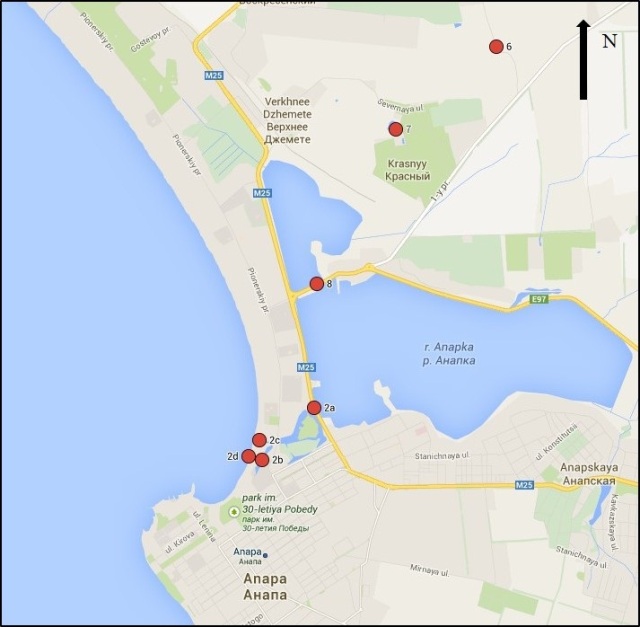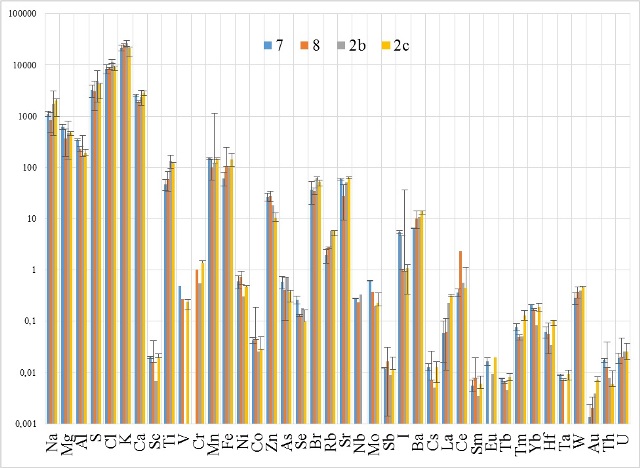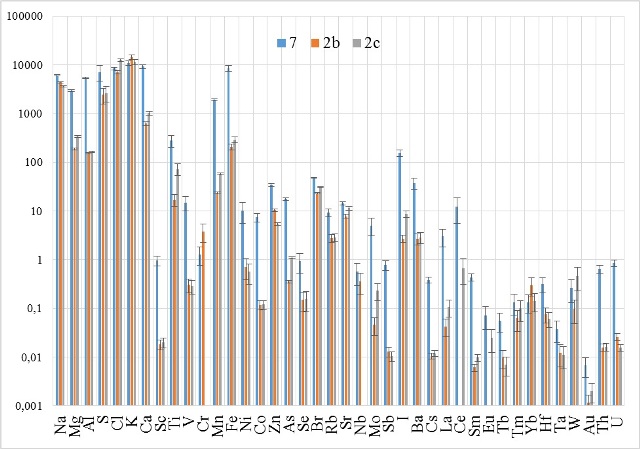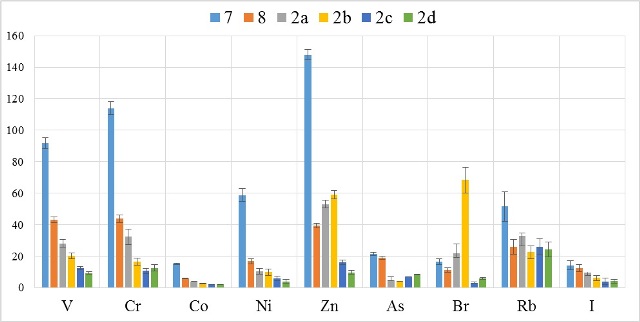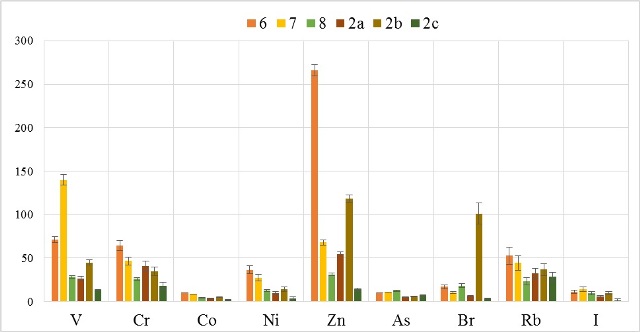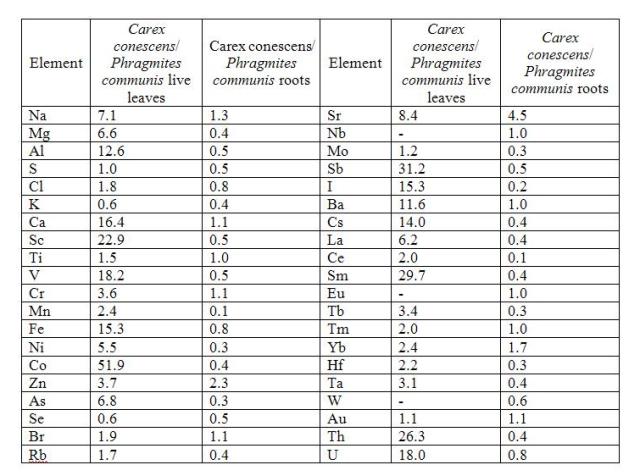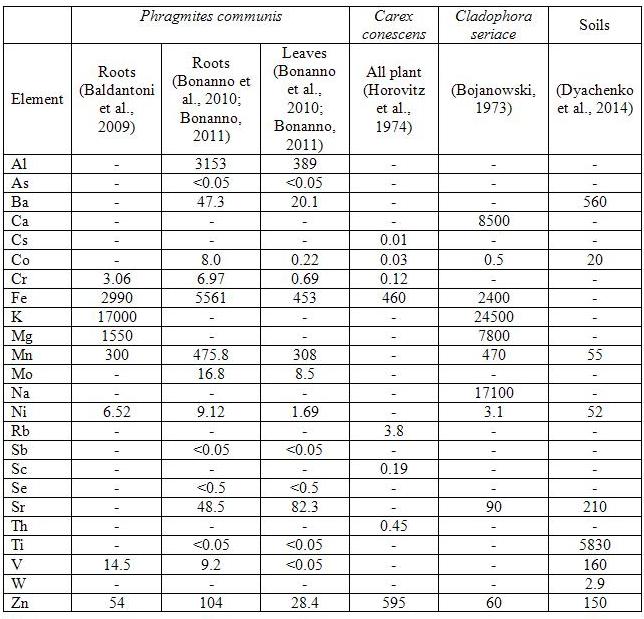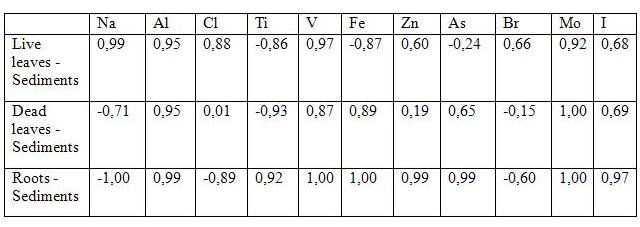
|
|
|
Оценка элементного состава макрофитов, почв и донных отложений вдоль трансекты в прибрежной зоне г. Анапы с помощью нейтронного активационного анализа
Камнев А.Н.1, Фронтасьева М.В.2, Кравцова А.В.2, Нехорошков П.С.2, Бунькова О.М.3, Стуколова И.В.1, Яковлев А.С.3, Зиньковская И.И.2, Alexander N. Kamnev1, Marina V. Frontasyeva2, Aleksandra V. Kravtsova2,
1Московский государственный университет им. М.В.Ломоносова, 1Lomonosov Moscow State University, Faculty of Biology
УДК 574.5 + 572.1/.4
С помощью нейтронного активационного анализа было определено содержание 41 макро- и микроэлементa в образцах макрофитов, почв и донных отложений, отобранных на 7 станциях вдоль разреза «антропогенный источник загрязнения – анапский городской пляж». Показано, что концентрации большинства элементов в образцах уменьшаются на 1-2 порядка при удалении от источника загрязнения. Ключевые слова: Phragmites communis, Carex conescens, Cladophora seriace, почва, донные осадки, макро- и микроэлементы, река Анапка, нейтронный активационный анализ.
Introduction Macrophytes are widespread plant species showing suitable characteristics for pollution biomonitoring, especially of trace elements (Bonanno, 2011). The emergent aquatic macrophytes Phragmites communis is one of the most common plants living in wet ecosystems. This plant can withstand extreme environmental conditions, including the presence of toxic contaminants such as heavy metals (Bonanno et al., 2010, Baldantoni, 2009). The objectives of this study were to determine the wide range of macro- and trace elements in Phragmites communis, Carex conescens, Cladophora seriace and corresponding soil and bottom sediments samples; to study the spatial variation of elements along the transect «anthropogenic source of pollution – Anapa city beach»; to compare the elemental accumulation in different organs of plants. This work represents the preliminary results of complex study in the Anapa region. Materials and methods Sampling The samples of macrophytes (live and dead leaves and roots of Phragmites communis and Carex conescens, algae Cladophora seriace (n=18) and the corresponding soil (n=16) and bottom sediment (n=9) samples were collected at 7 sites along the transect located near Anapa city in summer of 2013. The sampling sites and their description are shown in Fig 1.
Fig.1. Sampling sites in studied area near Anapa city (Anapa transect or cross-section)
Analysis Elemental analysis of the samples was carried out by INAA at the reactor IBR-2 of the Frank Laboratory of Neutron Physics of the Joint Institute for Nuclear Research, Dubna, Russia. The analytical procedures and the basic characteristics of the employed experimental facility are described in detail elsewhere (Frontasyeva, 2011). The samples of about 0.3 g were packed in polyethylene bags for short-term irradiation and in aluminum cups for long-term irradiation. To determine the short-lived isotopes of Mg, Al, Cl, Ca, Ti, V, Mn, S and I the samples were irradiated for 3 min in the reactor channel with a neutron flux density of 1.3·1012 n/(cm2 s). Gamma spectra of induced activity were measured for 12-15 min after 20 min of decay. The elemental contents of the long-lived isotopes of Na, K, Sc, Cr, Fe, Co, Ni, Zn, As, Se, Br, Rb, Sr, Zr, Mo, Sb, Cs, Ba, La, Ce, Nd, Nb, Sm, Tb, Tm, Yb, Hf, Ta, W, Au, Th, and U were determined using epithermal neutrons in a cadmium-screened irradiation channel with a neutron flux density of 1.6·1012 n/(cm2 s). Samples were irradiated for 90 h, repacked and then measured twice after 4–5 d of decay during 30 minutes and after 20 days of decay during 1.5 hours. To process gamma spectra of induced activity and to calculate concentrations of elements in the samples, software developed at FLNP, JINR was used (Dmitriev and Pavlov, 2013). The uncertainties in the determined concentrations were in the range of 5−15 %, and of 30 % or more for those elements which concentrations in the samples were at the detection limit, e. g. Nd, Tm, Yb. Quality control was provided by using standard reference materials: 433, 690CC, 1547, 1572, 1632b, 1633b, 2709, 2710 irradiated in the same conditions together with the samples under investigation. Results The average elemental concentrations followed different decreasing trends according to the kind of sample: in soil: Ca > Al > Fe, S> K > Na > Mg > Ti > Cl > Mn, Sr > Ba > Zn, Zr > V > Cr, Rb, Br > Ce > Ni > I, As, Nd > La > Co > Sc, Th, Dy, Mo, Nb, Hf > Sm, Cs, U > Yb, W, Sb > Eu > Tb, Ta, Se > Tm > Au; in bottom sediments: Ca > Al > Fe, S> K > Na > Mg > Ti > Cl > Sr > Mn > Ba > Zr > Zn >V,Cr > Rb > Br, Ce > Ni > I, As, La > Nd > Co > Sc, Th, Mo > Dy > Hf, Nb, Sm, Cs, U > Yb, W, Sb > Eu, Tb, Ta, Se > Tm> Au; in Phragmites communis: K > Cl > S> Na, Ca > Fe > Mg, Al > Mn > Ti > Sr, Br > I, Zn > Ba> Rb > As, Cr, Ce > V, Ni > Co, Mo > Nb, La, W > U, Yb, Sc > Th, Tm, Hf > Cs, Sm > Eu >Tb, Ta > Au; in Carex conescens: Ca > Cl > Na > K > S > Fe > Al > Ti, Sr, Mg > Br, Zn, Ba > I > Cr > Rb, V > As, Ni > Co, Ce > Mo, Nb, La > Yb > U, W, Sc > Th, Tm > Hf, Cs, Sm, Eu > Tb, Ta > Au; in Cladophora seriace: Ca > K > Cl > S, Al > Na, Fe > Mg > Sr > Ti, Br > Mn > Ba, I > Zn > Rb, V, As, Ce > Ni, Cr, La > Co > Sc > Th > Nb, Mo, Hf, W > Cs, Sm > U, Yb, Sb, Se > Eu, Tb, Tm, Ta > Au.
Spatial variation of macro- and trace elements in macrophytes, soil and bottom sediments samples Macrophytes Maximum concentrations of S, Cl, K, Ti, Br, As, Rb, Nb were observed in live leaves of Phragmites communis from station 2b, while the highest values of Na, Ca, Cr, Fe, Ba, REE, W were found at station 2c (Fig. 2). The content of Mg, Al, V, Mn, Se, Sr, Mo, I was 2-5 times higher at station 7 when compared to other sampling sites.
Fig. 2. Spatial variation of elemental concentrations in live leaves of Phragmites communis (stations 7, 8, 2b, 2c) (logarithmic scale).
Maximum values of the majority of elements (except for Cl, K and Cr) were observed in roots of Phragmites communis from station 7 (Fig. 3). Moreover, the concentrations of such elements as Al, Cs, V, Mn, Fe, Co, Mo, Sb, Cs, La, Sm, Th, and U at this station reached the values that are more than 30 times higher when compared to other sampling sites. The highest values of K, Cr and Cl were found in roots of Phragmites communis from stations 2b and 2c, respectively.
Fig. 3. Spatial variation of elemental concentrations in roots of Phragmites communis (stations 7, 2b, 2c) (logarithmic scale).
The concentrations of the majority of elements (except for Ca, Mn and Br) in green algae Cladophora seriace from stations 2c and 2d were very similar. The highest values of Ca, Mn and Br were found in Cladophora seriace from stations 2c and 2d, respectively. Bottom sediments Maximum concentrations of the majority of trace elements (except for Br and Sr) were observed in bottom sediments from stations 7 and 8 (Fig. 4). The highest concentrations of Br and Sr were found at station 2b.
Fig. 4. Spatial variation of some trace elements (mg/kg) in bottom sediments (stations 7, 8, 2a, 2b, 2c, 2d).
Soil Maximum concentrations of the majority of trace elements (except for Br) were observed in soils from stations 6 and 7 (Fig. 5). The highest concentration of Zn was found at station 6 (where anthropogenic source of pollution is located).
Fig. 5. Spatial variation of some trace elements (mg/kg) in soils (stations 6, 7, 8, 2a, 2b, 2c).
Interspecies variation in elemental accumulation The elements distribution among the three types of macrophytes samples had the following order: Cladophora seriace < Phragmites communis and Carex conescens. It was revealed that the concentrations of Al, Ca, Sc, V, As, Br, Sr, La, Ce, Sm, Th in Cladopfora were more than 10 times higher when compared to their content in Phragmites communis and Carex conescens. The results of comparison of elemental accumulation in live leaves and roots of Phragmites communis and Carex conescens are shown in Table 1.
Table 1. Ratio between elemental concentration in live leaves and roots of Phragmites communis and Carex conescens
The concentrations of all elements (except for S, K, Se, Au) were higher in live leaves of Carex conescens than in those of Phragmites communis. The biggest differences were observed in accumulation of Ca, V, Sc, Fe, Co, Sb, I, Sm, Th, and U (more than 15 times). The reverse regularity was found for the elemental accumulation in roots of Carex conescens and Phragmites communis. Concentrations in roots of Phragmites communis were usually higher (except for Na, Zn, Sr and Yb) than in roots of Carex conescens. Elemental accumulation in different organs of Phragmites communis The variation of elemental accumulation depending on organ of plant (live and dead leaves and roots) was studied in Phragmites communis sampled at station 7. Concentrations of Na, Mg, Al, Sc, V, Fe, Ni, Co, As, Nb, Mo, Sb, I, Ba, Cs, La, Ce, Sm, Eu, Tb, Tm, Ta, Au, Th, U decreased in the order of roots > dead leaves > live leaves. The decreasing bioaccumulation of S, Ca, Ti, Mn, Zn, Se, Br, Rb, Hf was roots >live leaves > dead leaves; regarding Cr, Yb, W, Sr ,the accumulation varied in the order of dead leaves > live leaves > roots. Maximum concentrations of Cl and K were found in live leaves and their minimum values were observed in dead leaves and roots, respectively. Discussion This study showed that elemental distribution among the different compartments decreased in the following order: soils, bottom sediments > roots > leaves. The obtained results confirmed the data that Phragmites communis is prevalently a root bioaccumulator species. It is also known that rooted macrophytes such as Phragmites communis influenced more by elements in sediments than by those in water (Baldantoni et al., 2009; Bonanno et al., 2010; Bonanno, 2011). Conversely it was observed that most elements in Carex conescens were accumulated in leaves. The elemental distribution in soils and bottom sediments along the transect was very similar. The highest values of the majority of elements were found in the samples from station 7. It is located in the distance of 1 km from the anthropogenic source of pollution, which is the source of air, soil, surface and ground waters pollution. Drainage waters penetrate into the local river system of Anapka river, carrying pollutants to the coast and dumping them on the way. Thus, soil, bottom sediments and macrophytes located on the direction of drains work as natural filters, reducing the elemental concentrations (Kambarova, 2011). The obtained results were compared to the available data reported by other authors (Table 2). The concentrations of most elements were higher in leaves and roots of Phragmites communis sampled in mountain lake in Italy (Baldantoni et al., 2009) and in the mouth of the longest Sicilian river (Bonanno et al., 2010; Bonanno, 2011) when compared to our result. The exceptions were Ti, Mn, As, Sb and Ti, V, As, Se which values, determined in this study, were higher in roots and leaves, respectively. The values of Co, Rb, Zn, and Th were higher in Carex conescens sampled in Germany in botanical garden (Horovitz et al., 1974) when compared to our results; the reverse trend was observed for Fe, Cr, Cs and Sc. The concentrations of Mg, Mn, Na and Zn were higher in Cladophora seriace from Baltic Sea (Bojanowski, 1973); and the values of Ca, Fe, Ni, Co and Sr were lower than those determined in this study. The concentrations of all elements (except for Mn and V) reported by Dyachenko et al., 2014 for the soils of South of Russia were higher than those, found in the soil samples from the most polluted station near anthropogenic source of pollution.
Table 2. Literature data on elemental concentrations (mg/kg) in Phragmites communis, Carex conescens, Cladophora seriace and soils The correlation coefficients counted for elemental concentrations in different organs of Phragmites communis and in soil showed positive correlation for Mg, Al, V, Mo, I between live leaves and roots and soils (Table 3). The opposite correlation coefficients were found for Na, Fe, Br, U in leave and dead leaves. It can be related to high regulation capacity of mentioned elements in live organs of plants.
Table 3. Correlation between average concentrations of some elements in different organs of Phragmites communis and concentrations in soil The similar correlation coefficients were observed between elemental concentrations in different organs of Phragmites communis and in bottom sediments (Table 4). The strong positive correlation was found between roots and bottom sediments except for Na, Cl and Br.
Table 4. Correlation between average concentrations of some elements in different organs of Phragmites communis and concentrations in bottom sediments Conclusion For the first time for the area of investigation the concentrations of Na, Mg, Al, Cl, K, Ca, Sc, Ti, V, Cr, Mn, Fe, Co, Ni, Zn, As, Se, Br, Rb, Sr, Zr, Nb, Mo, Sb, I, Cs, Ba, La, Ce, Nd, Sm, Eu, Tb, Dy, Yb, Hf, Ta, W, Au, Th and U were determined in different compartments: live and dead leaves and roots of Phragmites communis and Carex conescens, Cladophora seriace and corresponding soils and bottom sediments. The highest concentrations of majority of elements were found in roots of plants, soil and bottom sediments from station 7, which located 1 km far from anthropogenic source of pollution, which is the source of soil, surface and ground waters pollution. The study showed that elemental distribution among the different compartments decreased in the following order: soils, bottom sediments > roots of Phragmites communis > leaves of Phragmites communis. Conversely it was observed that most elements in Carex conescens were accumulated in leaves. The concentrations of all elements (except for S, K, Se, Au) were higher in live leaves of Carex conescens than in those of Phragmites communis. The biggest differences were observed in accumulation of Ca, V, Sc, Fe, Co, Sb, I, Sm, Th, and U (more than 15 times). The reverse regularity was found for the elemental accumulation in roots of Carex conescens and Phragmites communis. Concentrations in roots of Phragmites communis were usually higher (except for Na, Zn, Sr and Yb) than in roots of Carex conescens. The strong positive correlations between elemental concentrations in Phragmites communis and the environment suggest that this plant is potentially useful for monitoring pollution in general, and most elements examined in particular.
References 1. Baldantoni, D., Ligrone, R., & Alfani, A. Macro-and trace-element concentrations in leaves and roots of Phragmites australis in a volcanic lake in Southern Italy. // Journal of Geochemical Exploration. 2009. Vol. 101(2). P. 166-174. 2. Bojanowski, R. The occurrence of major and minor chemical elements in the more common Baltic seaweed. // Oceanologia 2. 1973. P. 81-152. 3. Bonanno, G. Trace element accumulation and distribution in the organs of Phragmites australis (common reed) and biomonitoring applications. // Ecotoxicology and environmental safety. 2011. Vol. 74(4). P. 1057-1064. 4. Bonanno, G., & Lo Giudice, R. Heavy metal bioaccumulation by the organs of Phragmites australis (common reed) and their potential use as contamination indicators. // Ecological Indicators. 2010. Vol. 10(3). P. 639-645. 5. Bunkova O., Kamnev A., Yakovlev A., Suhova T., Shahpenderyan E. Studying of mineral structure of Cystoseira barbata in a sublittoral zone of the northeast coast of the Black Sea. // World Conference on Marine Biodiversity, Qingdao, China, 12‐16 October 2014. Р.76. 6. Burdin K.S., Gavrylenko E.E., Zolotukhina E.Y., Kamnev A.N., Krupina M.V., Lyubimov M.V., Medvedeva G.V., Sizov A.D. Studying macrophytes seas of the USSR as objects of biomonitoring of heavy metals in the marine environment // In .: "Biology of the ocean." M., 1988, P. 16-25. 7. Burdin K.S., Kamnev A.N., Spiridonov V.A. Scientific, technical and economic problems of macroalgae to clean the marine environment from pollution // Science and Industry of Russia 2002. № 9. P.13-18. 8. Burdin K.S., Voskoboynikov G.M., Zubova E.V., Kamnev A.N., Krupina M.V. Marine macroalgae - monitoring objects // In .: Arctic Sea: bioindication, state of the environment, biological testing and technology degradation impurities. Murmansk Marine Biological Institute RAS, Apatity, 1993. P. 72-81. 9. Dmitriev A.Yu., Pavlov S.S. Automated quantitative determination of elements in samples by neutron activation analysis at the IBR-2 at the LNP JINR. // Physics of Elementary Particles and Atomic Nuclei. 2013. Vol. 10(1). P. 58-64. 10. Dyachenko, V., Matasova, I., & Ponomareva, O. The Trace Elements Concentrations Dynamics in the Soil Landscapes of the Southern Russia. // Universal Journal of Geoscience. 2014. Vol. 2(1). P. 28-34 11. Frontasyeva M.V. Neutron activation analysis for the Life Sciences. A review. // Physics of Elementary Particles and Atomic Nuclei. 2011. Vol. 42(2). P. 332-378. 12. Horovitz C.T., Schock H.H., Horovitz-Kisimova L.A. The content of scandium, thorium, silver, and other trace elements in different plant species. // Plant and Soil. 1974. Т. 40. №. 2. P. 397-403. 13. Kambarova, Е.A. The study of the problems of sustainable development of recreational centers Krasnodarskogo edge. (in russian). Proceedings of the IV all-russian scientific-practical conference "resort and recreation complex in the system of regional development: innovative approaches." April 15, 2011. – P.333. 14. Kamnev A.N. Environmental physiology of aquatic phototrophic organisms. Part 1. Water oxygenic phototrophs // Issues of modern algology - algology.ru. 2013. № 1 (3), URL: http://algology.ru/93 15. Kamnev A.N., Stukolova I.V., Fedorova T.A. Summary of the aquatic and coastal aquatic Northwest and Western Transcaucasia Black Sea // Issues of modern algology. 2014. № 3S (7S). Proceedings of the International Conference «Ecological physiology of aquatic phototrophic: distribution, stocks, chemical composition and use» III Sabininskie reading. Part2. URL: http://algology.ru/549 опубликовано - декабрь 2014 г.
Assessment of elemental composition of macrophytes, soil and bottom sediments along a transect in the coastal zone of Anapa, studied by neutron activation analysis Neutron activation analysis was used to determine elemental concentrations of 41 macro- and in macrophytes, soil and bottom sediments, sampled at 7 stations along the transect “anthropogenic source of pollution – Anapa city beach”. It was shown that the content of the majority of elements in the samples decreased by 1-2 orders of magnitude with increasing the distance from the source of pollution. Keywords: Phragmites communis, Carex conescens, Cladophora seriace, soils, bottom sediments, macroelements, trace elements, Anapka river, neutron activation analysis.
Об авторах Камнев Александр Николаевич - Kamnev Alexander Nikolaevich доктор биологических наук dr.kamnev@mail.ru Фронтасьева Марина Владимировна - Frontasyeva Marina Vladimirovna кандидат физико-математических наук marina@nf.jinr.ru Кравцова Александра Васильевна - Kravtsova Aleksandra Vasilevna аспирант Института Биологии Южных морей им. А. О. Ковалевского, Севастополь, Россия (Kovalevsky Institute of Biology of the Southern Seas, Sevastopol, Russia) инженер Сектора нейтронного активационного анализа и прикладных исследований Лаборатории нейтронной физики им. И. М. Франка Объединенного института ядерных исследований, г. Дубна, Россия (Sector of Neutron Activation Analysis and Applied Research, Frank Laboratory of Neutron Physics, Joint Institute for Nuclear Research, Dubna, Russia) alexkravtsova@yandex.ru Нехорошков Павел Сергеевич - Nekhoroshkov Pavel Sergeevich Бунькова Ольга Михайловна - Bunkova Olga M. аспирант ФГБОУ ВПО «Московский государственный университет им. Ломоносова», Москва, Россия (Lomonosov Moscow State University, Moscow, Russia), факультет почвоведения, кафедра оценки земельных ресурсов. BunkovaOlga@yandex.ru Стуколова Ирина Владимировна - Stukolova Irina V. ФГБОУ ВПО «Московский государственный университет им.М.В.Ломоносова», Москва, Россия (Lomonosov Moscow State University, Moscow, Russia), биологический факультет, кафедра физиологии растений iri_sk@inbox.ru Яковлев Александр Сергеевич - Yakovlev Alexander S. профессор, доктор биологических наук yakovlev_a_s@mail.ru Зиньковская Инга Ивановна - Zinicovscaia Inga Ivanovna кандидат химических наук Юшин Никита Сергеевич - Yushin Nikita Sergeevich инженер Сектора нейтронного активационного анализа и прикладных исследований Лаборатории нейтронной физики им. И. М. Франка Объединенного института ядерных исследований, г. Дубна, Россия (Sector of Neutron Activation Analysis and Applied Research, Frank Laboratory of Neutron Physics, Joint Institute for Nuclear Research, Dubna, Russia) Корреспондентский адрес: Россия, 119991, Москва, Ленинские горы, Московский Государственный Университет им.М.В.Ломоносова, д. 1, стр. 12, факультет почвоведения, кафедра оценки земельных ресурсов.
ССЫЛКА НА СТАТЬЮ: Камнев А.Н., Фронтасьева М.В., Кравцова А.В., Нехорошков П.С., Бунькова О.М., Стуколова И.В., Яковлев А.С., Зиньковская И.И., Юшин Н.С. Оценка элементного состава макрофитов, почв и донных отложений вдоль трансекты в прибрежной зоне г. Анапы с помощью нейтронного активационного анализа // Вопросы современной альгологии. 2014. 3S (7S). По Материалам Международной конференции «Экологическая физиология водных фототрофов: распространение, запасы, химический состав и использование» III Сабининские чтения. Ч.2. URL: http://algology.ru/647 Kamnev A.N., Frontasyeva M.V., Kravtsova A.V., Nekhoroshkov P.S., Bunkova O.M., Stukolova I.V., Yakovlev A.S., Zinicovscaia I.I., Yushin N.S. Assessment of elemental composition of macrophytes, soil and bottom sediments along a transect in the coastal zone of Anapa, studied by neutron activation analysis // Issues of modern algology. 2014. № 3S (7S). Proceedings of the International Conference «Ecological physiology of aquatic phototrophic: distribution, stocks, chemical composition and use» III Sabininskie reading. Part2. URL: http://algology.ru/647
При перепечатке ссылка на сайт обязательна
На ГЛАВНУЮ
|
|||
|
| ||
